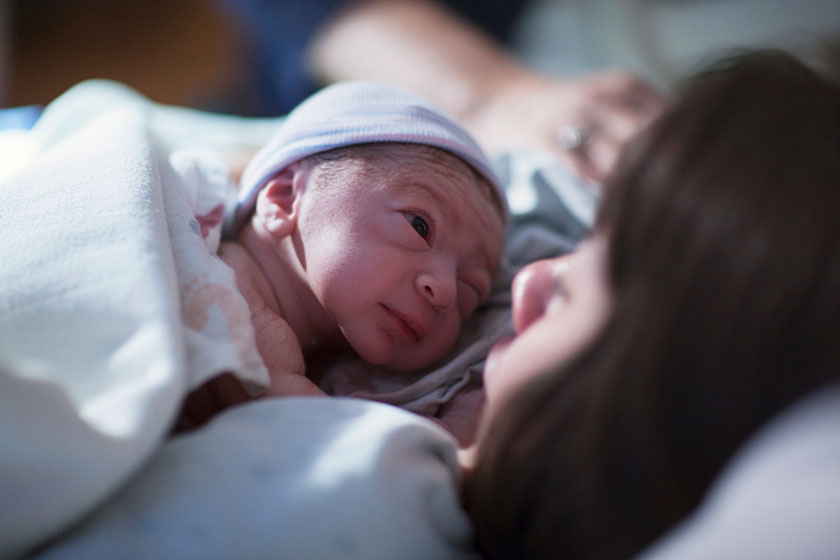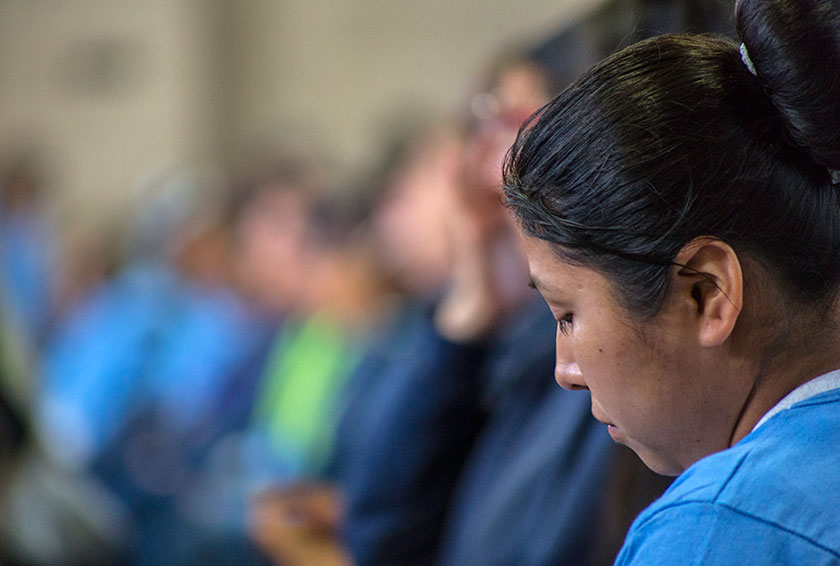Kate Trammell focused on her breathing. In-in-out. She was in labor with her first child. Contractions came every 30 seconds thanks to increasing doses of Pitocin. They had started hours ago.
Her husband sat next to her, holding her hand. Nurses stopped by often. They guided Kate to move to her side, shift her legs, or go for a walk down the hospital hallway. Together, Kate's husband and nurses encouraged and comforted her through the labor and delivery process.
Kate was in safe, capable, and helping hands. But she knew that not every woman giving birth that day in America was as lucky as she.
PERCENTAGE OF INCARCERATED WOMEN IS ON THE RISE
According to Kate, senior state campaign manager for Prison Fellowship®, "these are not small problems." For example, many female prisoners have limited access to feminine hygiene items, which can put them at risk for health problems. During situations that leave women vulnerable and exposed, such as using the bathroom or receiving medical attention, they are accompanied by correctional officers, many of whom are male. While this is done for security reasons, it raises issues concerning women's health and safety. Research shows that incarcerated women have faced higher rates of trauma, violence, and substance abuse prior to their incarceration than their male counterparts.
And in some areas of the country, where there is a very small population of women in prison, the only available correctional facilities to house women are maximum-security prisons. This means that no matter what a woman's conviction, she is placed in a highly-controlled environment out of proportion with her sentencing.

PRENATAL CARE IN PRISON IS A PRO-LIFE ISSUE
"That's about 11,000 women," Kate explains. While prisons offer some obstetrical care, less than half of pregnant women held in local jails receive any care at all.
"From a pro-life standpoint, this is unconscionable," Kate shared at a panel discussion on the needs of incarcerated women at the Conservative Political Action Conference (CPAC) in February. "The commission of a crime by the mother does not render the child unworthy of medical care. And, when rightly applied, a proportional sentence does not include a waiver of medical care for the mother, either."
Prior to her time at Prison Fellowship, Kate served as a magistrate for a rural Virginia county. She was sometimes sent to hospital delivery rooms to verify that the incarcerated women shackled to their hospital beds were indeed in active labor.
It was only then that the women's handcuffs could be removed, according to a judge's order of release.
"I noticed the look on their faces as they struggled [handcuffed] through contractions," Kate says. "Embarrassed. Resigned. Pained."
When it came time for Kate to deliver her own child, the memories of those women were ever present.
GIVING BIRTH IN CHAINS
For incarcerated women, pregnancy and childbirth can be a traumatic and dangerous experience. Rather than having a partner or family member present, the woman's only companions are often correctional officers. Many times, once the child is born, the mother must surrender the care of her child to someone else until her sentence is served.
"Added to this the awful reality is the practice of restraining incarcerated women throughout pregnancy and during delivery," Kate shares. Kate acknowledges that restraints during transport to and from correctional facilities are sound policy and are used for the protection of both the officers and the public. But even during transport, both best practices and common sense dictate that ankle restraints and so-called belly chains be avoided. And when it comes to labor and delivery, such restraints are almost never necessary.
"Having experienced labor, I can vouch for the fact that these women are not flight risks!" says Kate.
In recent years, common sense and best practices have led to the conclusion that restraining prisoners during labor and delivery is harmful. Restraints are now forbidden by the Federal Bureau of Prisons unless there is a documented security risk.
Even so, less than half of all states have outlawed this practice.
"Our pro-life values shouldn't stop at the prison gates," says Kate. "Policies designed as safety measures have to account for the safety of the laboring mother and her unborn child."

HOW CAN WE BETTER MEET THE NEEDS OF INCARCERATED WOMEN?
"The correctional environment is, yes, to punish," Kate says. "But it is also an opportunity to reach these women with the hope of a second chance. A chance to cultivate character change that will last for generations."
So, how can correctional facilities better meet the needs of incarcerated women?
REMOVE OF RESTRAINTS DURING LABOR AND DELIVERY
State policymakers can act to ensure that laws on the books no longer allow for the restraint of incarcerated women during labor and delivery, absent a documented immediate risk of harm. When a risk is documented, restraints should be used in the way that provides minimal risk to the health of the mother and unborn child.
PREPARE MOTHERS FOR PARENTHOOD
Departments of Corrections, wardens, and correctional officers can create policies that recognize the inherent dignity of women and the value of their unborn child. These policies include provision of routine prenatal and obstetrical care, parenting classes, and—when budget and safety concerns allow—in-prison nurseries.
Consequently, correctional facilities can ensure that there is a constructive culture and environment within prisons that prepares women for parenthood on the outside. For example, in some women's prisons, physical touch is completely prohibited. Though intended to keep fighting and abuse from occurring, these policies also stunt the emotional growth of the women behind bars.
Instead of choosing the most restrictive methods to keep prison environments safe, perhaps prisons should adopt the methods with the best outcomes.
STRENGTHEN THE COMMUNITY
While women are incarcerated, communities can provide needed stability and care for their kids who live on the outside. There are charitable organizations and churches stepping up across cities and counties to help reach these kids with needed services and the transformative power of the Gospel.
Stronger family and community connections are not only tied to reduced recidivism rates, but provide better opportunities for these children as they grow.
If the ultimate goal of the criminal justice system is to keep our communities safer, then we need to acknowledge the dignity and personhood of incarcerated women and their children.
OTHER STORIES YOU MIGHT LIKE
WOMEN OF IMPACT WALKING IN FREEDOM
Prison Fellowship Academy graduate Darcy shares her testimony and the calling God has on her life as a woman of impact walking in freedom.
"I delivered my baby girl, shackled to a hospital bed, in a vulnerable position exposed to all, without family and only corrections officers by my side."
DID YOU ENJOY THIS ARTICLE?
Make sure you don' t miss out on any of our helpful articles and incredible transformation stories! Sign up to receive our weekly newsletter, and you' ll get great content delivered directly to your inbox.
Your privacy is safe with us. We will never sell, trade, or share your personal information.